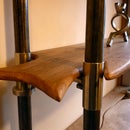Introduction: Leather Mountain Bike Grips
After one mushy blister too many, I set out to make some new leather mtb grips. I don't wear gloves when I ride - for me, they dull the responsive feelings of the bikes front end - so nice handlebar grips are important. Leather has an air of the 'organic', 'pure' and 'natural', that appeals to my romantic, and probably naive, barbarian tendencies. It may not have the same "quad-core compound for density advanced shock absorption system™", but similarly, I figured it would not leave horrible black bits all over my hands every ride.
If you make your own leather grips they can be responsive, a custom diameter that fits your own hand preferences, cost very little, designed not to twist or slip on the bars, and generally please the body and soul.
If you want to buy leather grips, you don't get a lot of choice and they are reasonably expensive (probably rightly so). There are two different styles, one simply wraps a big piece of leather round the bar, the other takes many small cross sectional circular pieces, and stacks them up over the bar. I thought the second type would produce a rougher, grippier and more sweat diffusing finish, so that's the way I went.
Step 1: Acquire the Stuff
For this project we want:
- Some leather (see below);
- One or two old bicycle wheel spokes - if you don't have any crisped old wheels (how?) then keep a look out for someone else's overly buckled rubbish;
- Some handlebar lock rings - these are cheap and effective little things that keep your grips on tightly (more on this later).
- An inner hole punch (we make this);
- An outer hole punch (we make this as well);
- A spoke-sized hole punch (I had this already, a fairly cheap handy tool to own);
- A vice, powerful clamp, or press of some kind;
- A hacksaw, electric drill, centre punch, and some beefy wire cutters.
Step 2: Make the Inner and Outer Punch
As we are going to use lots of ringlets of leather to 'build up' our grips, we will want some way to 'punch' the leather shapes. Cutting with a knife or scissors would take an eternity.
The inner hole wants to be the diameter of your handlebars. This is a fairly standard size on mountain bikes, and a small piece of handlebar makes an excellent punch (being the perfect size). With a bit of chamfering round the outer and inner edges of the bar section (or whatever metal tube you use), we can use it as a punch.
Many of the good mtb handlebars that you buy today come in very wide sizes, with the intention that they can be cut down to people's individual preference. For this reason, accruing some handlebar off cuts should not be a problem: even if you haven't bought new bars recently, your local bike shop probably does a lot of this 'cutting down' procedure so will have some end bits they could give you.
The outer hole punch is similar, but its diameter will give use the final size of the grip - the size we actually hold onto with our hands. So for this it is worth considering what size (diameter) you personally find pleasing to the hands. I am not a fan of fat grips, they tire out my forearms quickly. So yeah, find a tube of a size you like to hold onto and use that, but bare in mind it will need to be at lease an extra 5mm (diameter) or so than the inner punch, because we want to punch some small 2mm holes in the ringlets to secure them together (see step 5). I found an old headset cup (check here if you're not sure what that is) knocking about that had a perfectly delightful size and shape for this purpose. Again this is something you could probably find being thrown out of your local bike shop.
Step 3: Use the Punches
Ok so you have lovingly prepared your deadly sharp punches (actually they don't have to be too sharp so don't spend to long on them) and now its time to unleash them on some of that scrap leather. You will need to employ some kind of press. I used a bench vice, but I imagine that some kind of large G-clamp or similar would also work.
To begin with I was using a piece of hardwood as a striking plate for the punches - this was OK, but I found a solid piece of metal worked way better. Do some tests, find out what works for you, then go forth and make leather ringlets!
Make loads, until you think you have the desired thickness of one full grip. If you are like me you will put some on to your bars as you go, to check everything is ok and you haven't made any crazy miscalculations.
Step 4: Prep the Lock-on & Spoke System
We are going to keep our friendly leather ringlets bunched up together on the bars using the old grip lock rings (or 'lock-ons'). I already had some of these, as I used them to stop my grips sliding inwards on my handlebars (a glacial like phenomenon, it happens very slowly, but lock-ons are the only thing I have found that can stop it) . If you don't have any lock-ons then you could have a go at making some, or buy a set - they are relatively cheap, can be reused and do a good job.
So the ringlets will be squeezed together between the lock-ons. This will keep them in the right place, but we also need a way to prevent the ringlets from rotating on the bars. For this we can run a section of bicycle spoke through the ringlets and into some freshly made holes in the lock-ons.
So yeah, as in the photos, drill a 2mm hole in the lock-ons to receive the ends of the spoke. Drill the holes almost all the way through on, but not quite - so the spoke will not slip out. The spokes thread self-taps into a 2mm hole nicely.
Step 5: Do Some More Punching
We now need to make one little 2mm hole in all the leather ringlets, so that they will 'thread' onto the spoke. For this I used an actual hole punch tool, used for making holes in leather belts and the like. If you don't have one, it might be possible to sharpen up the end of the spoke and use it like a needle - threading on the ringlets. Alternatively, you could try and make a small punch or buy yourself one. They are useful, usually have a variety of small sizes, and are not too expensive.
Step 6: Stack Up Your New Grip
That's right, you're all ready to put it together....
At this point you simply thread together all your hard ringlet style work (see the photos). I experimented with different 'crushing ringlets together' methods. And found that simply squeezing them up tightly by hand, side-by-side, produced the nicest feel. When I used a clamp for more compression, the grip went too hard. So I guess if you like a super solid feeling grip, clamping may be for you.
At this point you may also want to experiment with small quantities of glue between ringlets, just to lock them all together (see the next step and comments for more on this).
Step 7: Grip Test!
I have been testing this leather grip jazz for a little while now, here's what I found.
My way of evaluating it was to ride with one average rubber grip and one leather one, and compare my hands. After a good variety of riding the leather grip looks good. It performed very well for a bunch of 'day-trip' rides (roughly 35km): all have been a mix of single track, rocky blasts, downhill and forestry roads in the Welsh hills. After the latest one my rubber gripping hand was blackened/rubberized and significantly more clammy/sweaty than my leather gripping one (both were still sore though). The hand gripping the leather felt dryer and more healthy and seems to have recovered/calloused up better. As well as feeling more healthy for my hand, they also seem to offer more control - they don't get 'sweat-slippy' like the rubber ones.
I have also done some more technical trialsy street type playing about, and while, again my hand feels better for the leather grip, I could detect a very slight amount of twist in the central section of the grip. Only a fractions of a millimetre, during particularly grip twisting moves, but certainly not desirable. Presumably the spoke is bending slightly in the centre, allowing the middle ringlets to shift slightly.
There is the option of adding another spoke, I suppose, or adding some sort of glue to bond the ringlets together (as the ringlets near the edges are solid this could help). But glue may not last well with the sweat, water and general abuse the grips get. And I don't really want to punch another spoke through the ringlets, as I suspect this will weaken the ringlets and therefore the whole grip.
So that problem aside (any thoughts on this people?), the grips are still some of the best I have ridden with, certainly the most satisfying!
Finalist in the
Humana Health by Design Contest













